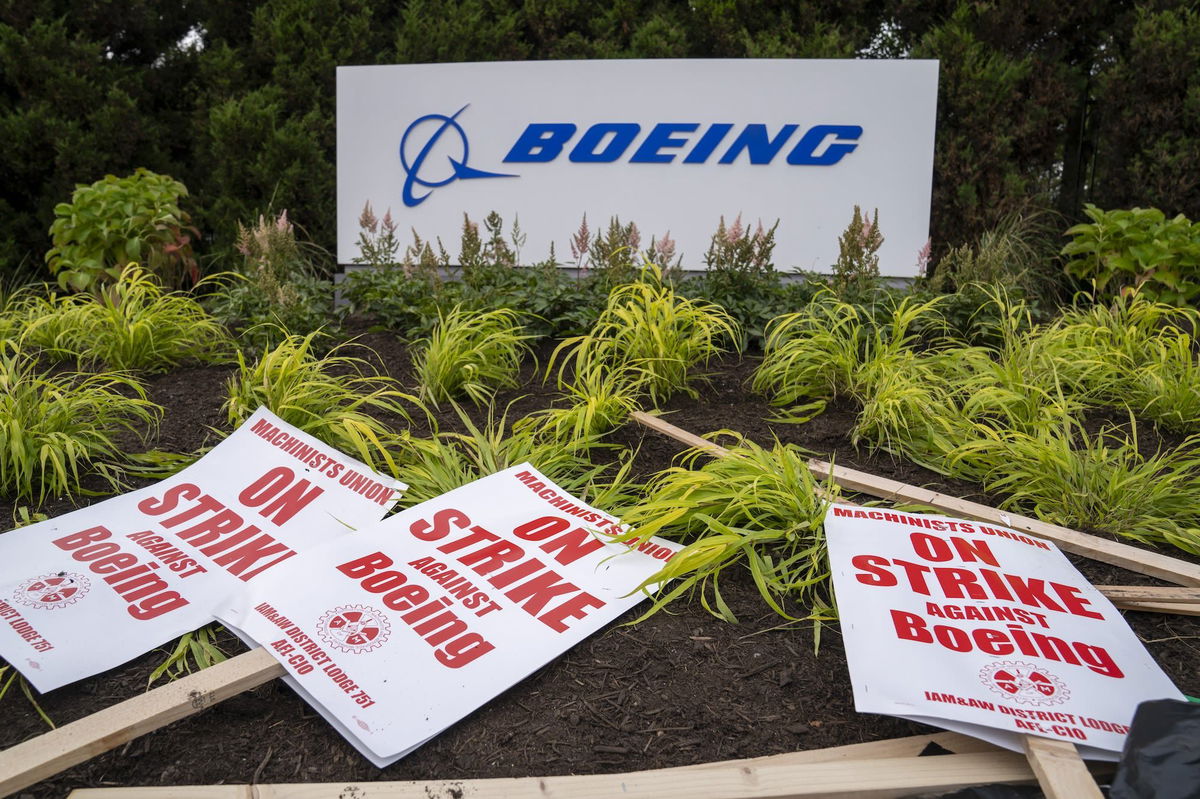Boeing got the easy part done. Now comes the tougher, existential problems

Picket signs outside the Boeing factory in Renton
New York (CNN) — Boeing’s most immediate problem – an eight-week strike by 33,000 workers – is over. But its more serious problems – ongoing massive losses, quality and safety problems – are as bad as ever, and could even get worse.
The last of those strikers return to work on Tuesday, but it will take weeks before airplanes start rolling off the production lines again, the company said Tuesday. It’ll be even longer before everything is back to pre-strike production levels.
“This isn’t something that there’s just a light switch that flips,” Boeing CEO Kelly Ortberg warned investors last month, even before machinists union members agreed to a deal. “We’re probably going to have a little bumpy return.”
And as nearly $40 billion in losses since 2019 have demonstrated, the pre-strike situation at Boeing was far from rosy.
Boeing’s outlook is still very troubled. Even with years of problems, it remains crucial to the American manufacturing base and economy. So its monumental challenges are important for far more than just one company.
Renewed problems in China
Among the most serious problems Boeing faces is President-elect Donald Trump’s promise to impose large tariffs on imports from China.
Boeing is America’s largest exporter, and therefore very exposed to any trade war. China is the largest global market for new aircraft purchases, with Boeing forecasting that China’s fleet of commercial jets will double in the next 20 years.
The aircraft maker has been down this road before. The company’s sales to China ground to a near-halt in 2017 as trade tensions between the two countries escalated during Trump’s first term. Orders from Chinese buyers fell from 64 in 2016 to 51 in 2017 to zero in both 2018 and 2019. A similar drop could occur if a new trade war breaks out.
“We really don’t know what Trump will do with Chinese tariffs,” said Richard Aboulafia, managing director at AeroDynamic Advisory, an industry consultant. “But if he slaps 60% tariffs on all Chinese goods, the quickest way for China to retaliate is to switch to (Boeing rival) Airbus for 100% of its needs.”
Boeing has seen a modest resumption of sales and deliveries to China recently, with 20 orders in 2021 and 15 in 2023. So far this year it has 53 deliveries to China, up from 35 in the four previous years combined.
Boeing declined to comment on the impact the election could have on its sales in China.
Increased oversight
Boeing has been under increased scrutiny from the Federal Aviation Administration since a door plug blew off of an Alaska Airlines flight in January, which has limited how many planes it is allowed to produce.
Even if Boeing ramps up production back to pre-January levels, the company still wouldn’t be profitable.
To increase production, it needs to improve quality to win the FAA’s approval. Boeing has already signaled it expects to lose money throughout 2025.
In addition, it has agreed to operate under the supervision of a court-appointed monitor overseeing safety and quality. That is part of a plea agreement that it reached to settle criminal charges that it deceived the FAA back during the certification of the Max.
“Generally, these sort of monitors make things harder,” said Aboulafia. “There needs to be a full accounting for everything they do.”
Need for new planes
And there’s yet more mess Boeing needs to sort out.
FAA approval for two new versions of the 737 Max, the smaller Max-7 and the larger Max-10, ground to a halt after Alaska Air incident.
Boeing has also continually pushed back the expected launch of its critical new widebody jet, the 777X. The plane, originally promised to customers by 2020, now won’t have its first delivery until at least 2026, after more problems during test flights.
And it needs much more than just newer versions of existing planes like the 737 Max and 777. It needs a totally new plane model to compete with the Airbus 321neo. Boeing has been talking about developing a longer-range, midsize plane for more than a decade, but those efforts were derailed by the problems of the last five years.
Ortberg told investors last month that Boeing needs to reduce its portfolio and repair its balance sheet so that Boeing has “a path to the next commercial aircraft.”
The good news for Boeing is it is in little danger of going out of business, despite its many problems. It is one of only two manufacturers, along with rival Airbus, that makes the full-size commercial jets needed by the world’s airline industry.
And Airbus has a backlog of orders stretching back years, as does Boeing, so airline customers can not easily switch orders from one to the other. Even as the Boeing machinists strike continued, the company received orders for 63 jets in October; buyers know the strike will be a distant memory by the time they are delivered.
But that doesn’t mean Boeing is in the clear.
“It could end up a permanent distant second, with conditions put in place for the emergence of a third provider,” said Aboulafia.
The-CNN-Wire
™ & © 2024 Cable News Network, Inc., a Warner Bros. Discovery Company. All rights reserved.